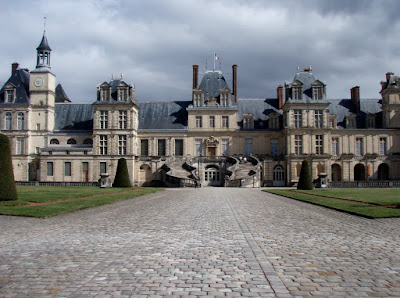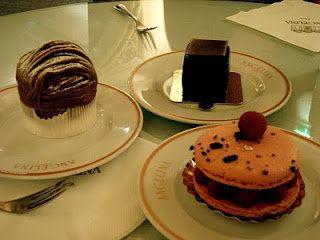Royal Visits
Any good guide book will tell you to take a day trip from Paris out to Versailles if time allows. It's that famous for a reason, people. However, if you're looking for something just as royal but not as frequented, go to Fontainbleau. It's just as accessible for a day trip, and it has its own perks for history buffs. Even less frequented, and, in my opinion, justly so, is Écouen, home of the Renaissance museum.

This medieval castle was taken over and renovated by several different rulers, the last of which was Napoleon, who constructed these famous staircases, and the first of which was Francois I, for whom Fontainbleau is most well known. Francois I took over this chateau out of a need to be close to the political life in Paris and, as the king was an avid hunter, a desire to reside in a calmer location close to a large hunting ground.
Another of the king's passions was art. He had world famous works like the Mona Lisa just hanging in his bathroom so that he could soak in the masterpieces as he soaked in the water from his bath. He felt that art nourished him and his political prowess, and he therefore surrounded himself with it. As such, one of the most famous parts of Fontainbleau is Francois I's personal gallery. As a Renaissance King's reputation for god-like knowledge was paramount, rulers worked hard to cloak themselves in an air of mystery and savoir. Francois I's gallery was opened but with one key, which the king himself possessed, which was a metaphor for his knowledge of the arts within. He would show very few people his collection, which bestowed immense honor on those who were let in and instilled great curiosity in those who were locked out. Because only the king and the artists who produced the works knew of all the symbolism in each work, art historians dispute the meaning of some paintings to this day.



Fontainbleau

This medieval castle was taken over and renovated by several different rulers, the last of which was Napoleon, who constructed these famous staircases, and the first of which was Francois I, for whom Fontainbleau is most well known. Francois I took over this chateau out of a need to be close to the political life in Paris and, as the king was an avid hunter, a desire to reside in a calmer location close to a large hunting ground.
Another of the king's passions was art. He had world famous works like the Mona Lisa just hanging in his bathroom so that he could soak in the masterpieces as he soaked in the water from his bath. He felt that art nourished him and his political prowess, and he therefore surrounded himself with it. As such, one of the most famous parts of Fontainbleau is Francois I's personal gallery. As a Renaissance King's reputation for god-like knowledge was paramount, rulers worked hard to cloak themselves in an air of mystery and savoir. Francois I's gallery was opened but with one key, which the king himself possessed, which was a metaphor for his knowledge of the arts within. He would show very few people his collection, which bestowed immense honor on those who were let in and instilled great curiosity in those who were locked out. Because only the king and the artists who produced the works knew of all the symbolism in each work, art historians dispute the meaning of some paintings to this day.



Écouen
This Renaissance castle is famous enough to escape an American French teacher's mouth as a recommended day trip to one of his students in Paris, but not famous enough to even be in the vocabulary of a born and raised Parisian. I'm hoping the reason for this is that the French professor liked Écouen for it's intellectual appeal, but I'm leaning towards the assumption that the recommendation came from reading about the castle and not from visiting it. I do not mean to mercilessly pick on this castle. Unlike Fontainbleau, which was a medieval castle renovated during the Renaissance into the modernity of several successive styles of the age, Écouen was purely Renaissance. It has some impressive tapestries, ornate wooden furnishings, and a countless number of royalty symbols painted and engraved around the castle for a history nerd to go seek. However, the best part of my trip was the view from the castle overlooking the tiny houses clustered around vast fields of green grass and bright yellow flowers, and the saliva-inducing lemon tart I picked up at the neighborhood bakery afterwards. The tart was really great, but if I were you, I'd just go to Versailles or Fontainbleau, and then pick up a pastery on the way home.


I think Fontainebleau is with an "e"; in fact, I'm quite sure of this.
ReplyDelete